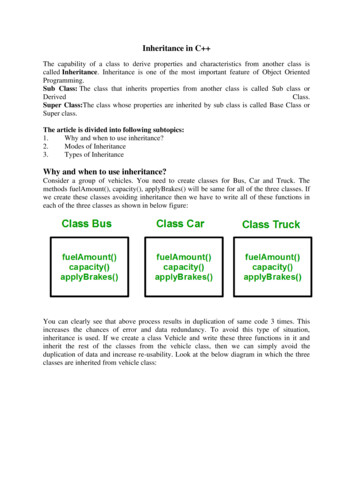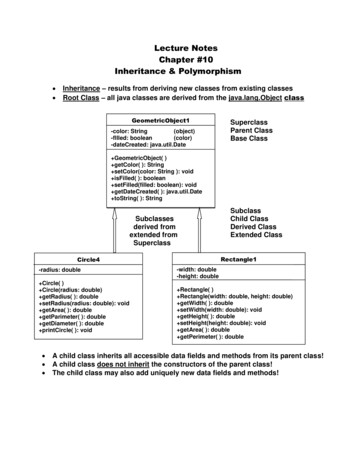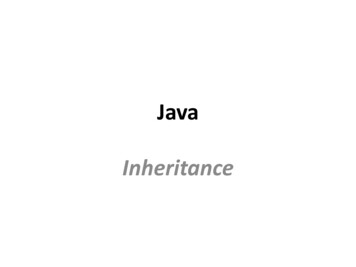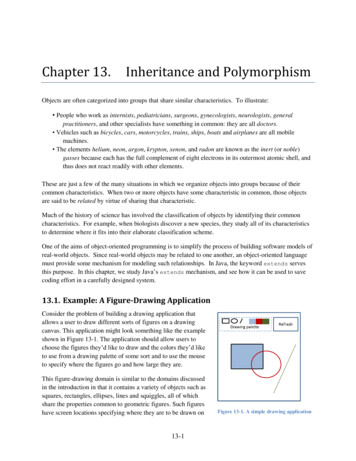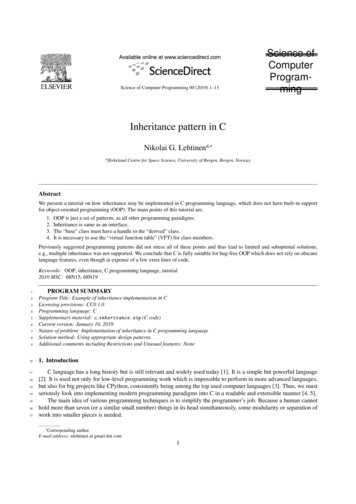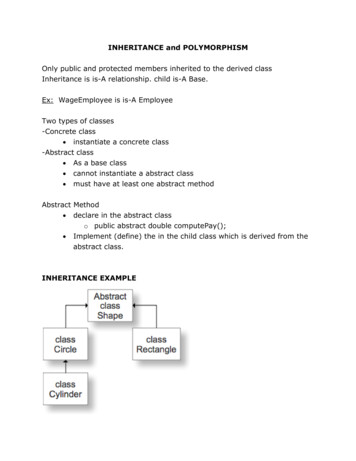
Transcription
INHERITANCE and POLYMORPHISMOnly public and protected members inherited to the derived classInheritance is is-A relationship. child is-A Base.Ex: WageEmployee is is-A EmployeeTwo types of classes-Concrete class instantiate a concrete class-Abstract class As a base class cannot instantiate a abstract class must have at least one abstract methodAbstract Method declare in the abstract classo public abstract double computePay(); Implement (define) the in the child class which is derived from theabstract class.INHERITANCE EXAMPLE
/**class description*/public abstract class Shape{private double xPos;private double yPos;/** default-argument constructor*/Shape (){xPos 0;yPos 0;}/** A constructor to assign values to pos & yPos@param int x position@parma int y position*/Shape (double x, double y){xPos x;yPos y;}/** get the xPos@return int xPos*/public final double getxPos()//final: cannot override the method in the derived class{return xPos;}2
public final double getyPos(){return yPos;}public void moveTo(double x, double y){xPos x;yPos y;}public String toString(){ return “x “ xPos “ y “ yPos;}public abstract double computeArea();}//end class Shapepublic class Circle extends Shape{private double radius;Circle(){super(); //call Shaperadius 0;}// argument Circle constructorpublic Circle (double x, double y, double r){super(x,y); //call Shape(x,y)radius r;}public double computeArea(){return Math.PI * radius * radius;}public double getRadius(){return radius;}3
public String toString(){return super.toString() “Radius “ radius;}}//end class Circlepublic Cylinder extends Circle{private double height;private double z;public Cylinder(){super();height 0.0;z 0.0}public Cylinder(double x, double y, double r, double h, double z){super(x,y,r); //call Circle 3-arg constructorheight h;this.z z}4
public void moveTo(double x, double y, double z){super.moveTo(x,y);this.z z;}public double computeArea(){return 2 * super.computeArea() 2.Math.PI * getRadius() *height;}public double computeVolume(){return super.computeArea() * height;}5
public double getHeight(){return height;}}//end classSummary Extends Is-A relationship describes inheritanceo Class B extends A o B Is-A AUse inheritance when Is-A relationship makes sense.no multiple inheritancemultiple interface inheritancesuper()o call the parent constructorIf the method is overridden in the subclass, use super.method tocall the method of the baseProtected is like private except it is inherited to the subclass.6
Polymorphismpublic class TestShape{ main( ){Shape [] s new Shape[5];s[0] new Circle(10.0,2.0.5.0);Circle c2 new Circle(5.0,1.0,3.0);s[1] c2;s[2] new Rectangle( );s[3] new Cylinder( );s[4] new Cylinder( );//Total area of all objectdouble total 0.0;for(int i 0; i s.length; i ){total s[i].computeArea();}7
//Total area of all Rectangle objectsdouble sumArea 0.0;for(int i 0; i s.length; i ){if(s[i] instanceof Rectangle)sumArea s[i].computeArea;}//Total volume of Cylindersdouble totalVolume 0.0;for(int i 0; i s.length; i ){if(s[i] instanceof Cyclinder)totalVolume ((Cylinder) s[i]).computeVolume();}8
UML (Unified Modeling Language ) Diagram- private members public member# protected memberexample:9
Compositioncomposition – has a relationshipUse composition when you do not know clearly the is-a relationshippublic class Book{String code;String title;double price;public Book(){code “”;title “”;price 0.0;}public Book(String c, String t, double p){code c;title t;price p;} }public double getPrice(){return price;}public void setBook(Book bb){b bb;}10
public class BookOrder{private Book book;private int quantity;private double total;public BookOrder(){book new Book();quantity 0;total 0.0;}}public BookOrder(String c, String t, double p, int q, double tot){book new Book(c,t,p);quantity q;total tot;}public void setTotal(){total quantity * book.getPrice();}public Book getBook(){return book;}INTERFACEInterface can contains only abstract method (no keyword abstract) andconstant variables. The class implementing interfaces must define all theabstract methods.public interface B{constant variables;abstract methods; //No keyword public}11
In Java, multiple inheritances are not allowed, but multiple interfaces are.public class D extends A implements B, C{ .}Ex:interface Animal {public void eat();public void travel();}/* File name : MammalInt.java */public class MammalInt implements Animal{public void eat(){System.out.println("Mammal eats");}public void travel(){System.out.println("Mammal travels");}public int noOfLegs(){return 0;}public static void main(String args[]){MammalInt m new MammalInt();m.eat();m.travel();}}This would produce the following result:ammal eatsammal travelsJava interface ComparableComparable interface is used to order the objects of user-defined class.Thisinterface is found in java.lang package and contains only one method namedcompareTo(Object).It provide only single sorting sequence i.e. you can sort12
the elements on based on single datamember only.Syntax:public interface Comparable{int CompareTo(Obj o);}Example:Student.javaclass Student implements Comparable{int rollno;String name;int age;Student(int rollno,String name,int age){this.rollno rollno;this.name name;this.age age;}public int compareTo(Object obj){Student st (Student)obj;if(age st.age)return 0;else if(age st.age)return 1;elsereturn -1;}}SimpleJava.javaimport java.util.*;import java.io.*;class TestSort3{public static void main(String args[]){ArrayList al new ArrayList();al.add(new Student(101,"Vijay",23));13
al.add(new Student(106,"Ajay",27));al.add(new Student(105,"Jai",21));Collections.sort(al);//If you an array named ar, then the sort statement should be//Array.sort(ar);Iterator itr al.iterator();while(itr.hasNext()){Student st (Student)itr.next();System.out.println(st.rollno "" st.name "" st.age);}}}Output105 Jai 21101 Vijay 23106 Ajay 2Java Comparator interfaceComparator interface is used to order the objects of user-defined class.This interface is found in java.util package and contains 2 methods compare(Object obj1,Object obj2) and equals(Object element).It provides multiple sorting sequence i.e. you can sort the elements basedon any data member. For instance it may be on rollno, name, age oranything else.Syntaxpublic int compare(Object obj1,Object obj2): compares the first object withsecond object.Example of sorting the elements of List that contains user-defined classobjects on the basis of age and nameIn this example, we have created 4 java or.javaSimple.java14
Student.javaThis class contains three fields rollno, name and age and a parameterizedconstructor.class Student{int rollno;String name;int age;Student(int rollno,String name,int age){this.rollno rollno;this.name name;this.age age;}}AgeComparator.javaThis class defines comparison logic based on the age. If age of first object isgreater than the second, we are returning positive value, it can be any onesuch as 1, 2 , 10 etc. If age of first object is less than the second object, weare returning negative value, it can be any negative value and if age of bothobjects are equal, we are returning 0.import java.util.*;class AgeComparator implements Comparator{public int Compare(Object o1,Object o2){Student s1 (Student)o1;Student s2 (Student)o2;if(s1.age s2.age)return 0;else if(s1.age s2.age)return 1;elsereturn -1;}}NameComparator.javaThis class provides comparison logic based on the name. In such case, we are using thecompareTo() method of String class, which internally provides the comparison logic.15
import java.util.*;class NameComparator implements Comparator{public int Compare(Object o1,Object o2){Student s1 (Student)o1;Student s2 (Student)o2;return s1.name.compareTo(s2.name);}}Simple.javaIn this class, we are printing the objects values by sorting on the basis of name and age.import java.util.*;import java.io.*;class Simple{public static void main(String args[]){ArrayList al new ArrayList();al.add(new Student(101,"Vijay",23));al.add(new Student(106,"Ajay",27));al.add(new Student(105,"Jai",21));System.out.println("Sorting by Name.");Collections.sort(al,new NameComparator());Iterator itr al.iterator();while(itr.hasNext()){Student st (Student)itr.next();System.out.println(st.rollno " " st.name " " st.age);}System.out.println("sorting by age.");Collections.sort(al,new AgeComparator());Iterator itr2 al.iterator();while(itr2.hasNext()){Student st (Student)itr2.next();System.out.println(st.rollno " " st.name " " st.age);}}}16
OutputSorting by Name.106 Ajay 27105 Jai 21101 Vijay 23Sorting by age.105 Jai 21101 Vijay 23106 Ajay 27Differences between Comparable and ComparatorComparable and Comparator both are interfaces and can be used to sortcollection elements.But there are many differences between Comparable and Comparatorinterfaces that are given below.ComparableComparator1) Comparable provides single sortingComparator provides multiple sorting sequence. Insequence. In other words, we can sort theother words, we can sort the collection on the basis ofcollection on the basis of single elementmultiple elements such as id, name and price etc.such as id or name or price etc.2) Comparable affects the original class Comparator doesn't affect the original class i.e.i.e. actual class is modified.actual class is not modified.3) Comparable provides compareTo()Comparator provides compare() method to sortmethod to sort elements.elements.4) Comparable is found in java.langComparator is found in java.util package.package.5) We can sort the list elements ofWe can sort the list elements of Comparator type byComparable type byCollections.sort(List,Comparator) method.Collections.sort(List) method.17
Operator and the Object method equalsThe operator tests whether two references are the sameobjects(referential equality)Circle c1 new Circle(1.0,2.0,3.0);Circle c2 c1;if (c1 c2) //returns true based on reference not valueCircle c1 new Circle(1.0,2.0,3.0);Circle c2 new Circle(1.0,2.0,3.0);if (c1 c2)// falseOverriding the method equals for logical equality.public class Circle(){ public Boolean equals(Object otherobject){if ( otherobject instanceof Circle){return radius ((Circle) otherobject).radius;}else{return false;}}}Circle c1 new Circle(1.0,2.0,3.0);Circle c2 new Circle(1.0,2.0,3.0);if (c1.equals(c2)) // true18
CloneSometimes you want to make a copy of an object.c1 c2;The statement above does not create a duplicate object.It simply assigns the reference of c2 to c1. To create an object with separatememory space use the clone() method.Java interface Cloneable The object cloning is a way to create exact copy of an object. Forthis purpose, clone() method of Object class is used to clone anobject.The java.lang.Cloneable interface must be implemented by theclass whose object clone we want to create. If we don't implementCloneable interface, clone() method generatesCloneNotSupportedException.The clone() method is defined in the Object class. Syntax of theclone() method is as follows:protected Object clone() throws CloneNotSupportedExceptionThe clone() method saves the extra processing task for creating the exactcopy of an object. If we perform it by using the new keyword, it will take alot of processing to be performed that is why we use object cloning.public class Book implements Cloneable{private String title;private String code;private double price;public Object clone() throws CloneNotSupportedException{return super.clone();}}In the main()Book b1 new Book( );Book b2 (Book) b1.clone();Note: If you do not modify clone() and have objects in the object, you willmake a shallow copy19
Deep copypublic class Bookorder implements Cloneable{private int quantity;private double total;private Book book;public void setBook(Book b){ book b;}public Object clone() throws CloneNotSupportedException{Bookorder b (Bookorder) super.clone;book (Book) book.clone;b.setBook(book);return b;}}In the main()Bookorder b1 new Bookorder( );Bookorder b2 (Bookorder) b1.clone();20
Inheritance, interface and castingRecall that inheritance implements the "is-a" relationship. For example, inthe Introduction to Inheritance notes, class RaceHorse was defined to be asubclass of Horse (because every RaceHorse is a Horse). Therefore, it makessense that a RaceHorse can be used in any context that expects a Horse. Forexample:Horse h;RaceHorse r new RaceHorse();h r;21
Variable h is of type Horse, so in an assignment of the formh .the right-hand side of the assignment should be of type Horse, too.However, since a RaceHorse is-a Horse, it is OK for the right-hand side to beof type RaceHorse, as in the above example.Note that every Horse is not a RaceHorse, so in general, a Horse cannot beused when a RaceHorse is expected. For example, the following code causesa compile-time error:Horse h new Horse();RaceHorse r h;Here are three more examples of code that sets a Horse variable orparameter to point to a RaceHorse object:(1)Horse h new RaceHorse();(2)public static void f( Horse h ) { . }.RaceHorse r new RaceHorse();f( r ); // f's formal parameter h is of type Horse, but the actual// parameter points to a RaceHorse object(3)}public static RaceHorse g() { // return a pointer to a RaceHorse object.Horse h g();// h is of type Horse, but it points to a// RaceHorse object// h is of type Horse, but it now points to a RaceHorse// objectIf you know that at a particular point in your code a Horse variable is reallypointing to a RaceHorse object, then you can use that variable in a contextthat expects a RaceHorse, but you must provide a cast. Note that there aretwo kinds of errors that can arise if you get this wrong:1. missing cast compile-time error2. incorrect cast runtime error (ClassCastException is thrown)Examples:Assume that we have the following declarations of function f and variablesh1 and h2:public static void f( RaceHorse r ) { . }Horse h1 new RaceHorse();Horse h2 new Horse();22
Now consider the following three calls to f:1. f(h1); // compile-time error (missing cast)2. f( (RaceHorse)h1 ); // fine! h1 really does point to a RaceHorse3. f( (RaceHorse)h2 ); // runtime error (bad cast) h2 points to a HorseNote that when you use a cast you must think about what expression youare casting, and perhaps use parentheses (if that expression is part of alarger expression). For example, suppose variable h is of type Horse butactually points to a RaceHorse. You can call h's WinRace method (which is aRaceHorse method, but not a Horse method), but you have to use a cast,like this:((RaceHorse)h).WinRace();The parentheses tell the compiler that you are casting just variable h to beof type RaceHorse. If you omit the parentheses:(RaceHorse)h.WinRace(); // NO! This doesn't work!!the compiler will think you are casting the result of the call h.WinRace() tobe of type RaceHorse.23
Is-A relationship describes inheritance o Class B extends A o B Is-A A Use inheritance when Is-A relationship makes sense. no multiple inheritance multiple interface inheritance super() o call the parent constructor If the method is overridden in the


